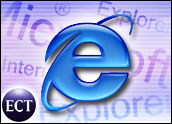
Microsoft on Wednesday announced its intent to distribute Internet Explorer 7 (IE7) as a “high-priority” update through Automatic Updates (AU) for Windows XP. The software giant’s goal is to help its customers browse the Web in more secure environments.
“To ensure users are prepared to upgrade, AU will notify users when IE7 is ready to install and show a welcome screen that presents key features and choices to ‘Install,’ ‘Don’t Install,’ or ‘Ask Me Later,'” said Microsoft Group Program Manager Tony Chor.
All About Security
The final version of IE7 is scheduled to be released for Windows XP during the fourth quarter of this year, with safety and security at the fore of the new version. IE is designed to help protect users against malicious software and keep personal data safe from fraudulent Web sites and online phishing scams.
Microsoft is also adding several other enhancements to its next-generation browser, including an ActiveX Opt-in and a Fix My Settings feature. The company is highlighting a cleaner look and more streamlined setup that includes tabs for browsing multiple pages in one window. Considering the number of updates, Microsoft is recommending that all Genuine Windows users install IE7.
AU will notify customers when IE7 is ready to install. Alternately, users can visit the Windows Update or Microsoft Update sites and download IE7 by performing an “express” scan for high-priority updates. Either way, Chor said users will see the welcome screen that allows them to choose whether to install the new version.
To Install or Not to Install?
If users decide to install IE7, it will preserve their current toolbars, home page, search settings, and favorites. Installing will not change the user’s choice of default browser.
Users will also be able to roll back to IE6 at any point by using the “Add/Remove Programs” option in the Control Panel. Microsoft stressed that users who have AU turned off will not be notified.
“I think this approach strikes a good balance across a couple of dimensions — helping customers become more secure, giving them control, and providing options for enterprises,” Chor noted.
Blocking IE7
For enterprise customers, Microsoft is providing a Blocker Toolkit that will allow IT managers to block automatic delivery of IE7 to their organizations. The blocker, which has no expiration date, is freely available from the Microsoft Download Center.
“A lot of businesses won’t want to deploy Internet Explorer 7 right away. They will want to test it for a while before using it as their standard browser,” JupiterResearch analyst Joe Wilcox told TechNewsWorld. “The ability to block the auto update is a move to cater to businesses.”
Beyond tabbed browsing, IE7 also makes printing easier by automatically shrinking text so all Web page content fits on the final printed page. Users can adjust margins, customize page layouts, remove headers and footers and change the print space.
IE7 also integrates search directly into the browser with an instant search box and lets users subscribe to RSS feeds so information feeds are delivered directly to the desktop.





















































Smart.